Re-Made in China
Those nifty wooden chests and old-style cabinets aren't the only Chinese reproductions pouring forth from the mainland. Imperial pottery factories have been re-fired to churn out copy China that unwitting collectors buy for millions, while paintings and other forgeries flow through the finest museums and auction houses. China has become renowned as the world capital of art forgery, which is only fitting, since fraud is considered a fine art in the Middle Kingdom.
By Ron Gluckman /in Beijing, Shanghai, Zongshan, Jingdezhen, Hong Kong and Macau
PABLO PICASSO once proclaimed, "We all know that art is not truth." Collectors visiting China quickly become even more cynical. With art here, there is no truth.
Nobody knows that better than Dick Wang, who enjoys a rare perspective on Beijing’s red-hot market in art and antiquities. From the second-floor window of his gallery, Wang looks down on Liulichang, a shopping street popular with tourists and locals alike. Many visit the stylish Wang & Co. and show off treasures they’ve mined from nearby markets. "All of them are fake," he says.
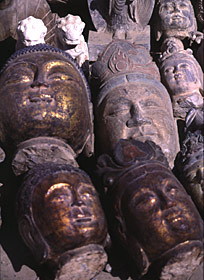 Getting
burned is common, and not even Wang, who worked for five years as an expert on
Chinese art at auction house Sotheby's in London and New York, is immune. A few
years back he bought a Tang dynasty horse for $12,000—a steal, or so he
thought. It turned out to be a well made but worthless fake. "I call that
my tuition," he says with a smile.
Getting
burned is common, and not even Wang, who worked for five years as an expert on
Chinese art at auction house Sotheby's in London and New York, is immune. A few
years back he bought a Tang dynasty horse for $12,000—a steal, or so he
thought. It turned out to be a well made but worthless fake. "I call that
my tuition," he says with a smile.
Forgery is hardly new in the art world, but China is considered a leader in the field. Bogus pieces constitute as much as 80 percent of the value of goods for sale in Hong Kong, and are even showing up in museums, auction houses, and high-end galleries. Most of those pieces probably originate in China. ''You find copying everywhere people collect art, but, when it comes to art fraud, China is probably the world capital," says one Beijing art consultant.
"There are so many fakes in the market," adds Alfreda Murck, who was one of the New York Metropolitan Museum's Asian art curators. Now she authors art books in Beijing, where she sees firsthand a market flooded with fakes. "Telling them from the real thing is sometimes impossible."
Liulichang Street, Beijing’s Antique Alley, doesn’t look ominous. A few blocks south of Tiananmen Square, it has scores of charming wooden, tile-roofed shops displaying weathered pottery, furniture, books and bric-a-brac. Tourists have strolled the quaint cobbled lane for ages, even if they aren’t hunting for any particular treasure. Street touts pounce on potential marks, pushing forward photo albums.
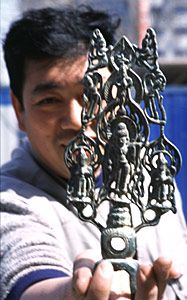 "You
want Qing?" asks one, pointing to photos of prized porcelain. "Yuan
and Song pieces, one thousand years old, very cheap!" Huge vases,
meticulously glazed plates, and bronze statues are offered, all at prices that
are unbelievable—if the pieces are real. None are, says Wang. "Probably
ninety-five percent of the stuff you find on the streets is fake," he
declares. And what's true in Beijing is mirrored in antique markets across
China.
"You
want Qing?" asks one, pointing to photos of prized porcelain. "Yuan
and Song pieces, one thousand years old, very cheap!" Huge vases,
meticulously glazed plates, and bronze statues are offered, all at prices that
are unbelievable—if the pieces are real. None are, says Wang. "Probably
ninety-five percent of the stuff you find on the streets is fake," he
declares. And what's true in Beijing is mirrored in antique markets across
China.
One need only tour the border areas around Hong Kong and Macau to grasp the size of the problem. Huge antique showrooms, one after another, tempt bargain hunters from the wealthy former British and Portuguese colonies.
At Chinese Antique Market, north of Macau, 100 tin-roofed stalls bulge with dusty tables, baskets, and carved wooden panels. Trucks arrive regularly, piled high with old dressers and cabinets. Most are refinished and sold on the premises, but there is also a huge market for reproductions or modern copies. Many are sold as the real thing, for ridiculously inflated prices.
Some shops tread carefully. Sam at Yong Chang Furniture Plant of Classical Arts avoids using terms like antique. "These pieces are all made in the old style," he says instead.
Sam respects the fine line between fraud - passing off a forgery as genuine - and copying, which is considered a genuine art form in China. "The best artists in China always learned by copying," notes the Beijing art consultant, who often works for the Chinese government and wishes to remain anonymous. "They did so for centuries, and that’s still the case."
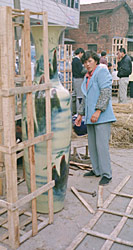 Nowhere
is that clearer than in Jingdezhen, a grim town in southeastern China. Covered
by a gray haze, Jingdezhen might resemble any other ugly industrial city in
China, except for the magnificent 12-foot-tall vases lining both sides of the
main street, home to the world’s largest porcelain market.
Nowhere
is that clearer than in Jingdezhen, a grim town in southeastern China. Covered
by a gray haze, Jingdezhen might resemble any other ugly industrial city in
China, except for the magnificent 12-foot-tall vases lining both sides of the
main street, home to the world’s largest porcelain market.
Small alleys branch off in every direction, heaped high with plates, bowls, figurines, and tacky ware such as Mao salt shakers, Mickey Mouse casseroles, Princess Di plates, and Pueblo-style ashtrays. Many shops carry finer pieces that look misplaced amidst all the kitsch: thousand-year-old urns, Qing goblets, and ancient plates with intricately-cracked glaze. They look authentic, but all are copies.
The high-fire process of making porcelain was invented in China around the fourth century. In Jingdezhen, it became a sophisticated art form that reached its zenith in a period spanning the Ming (1368-1644) and Qing (1644-1911) dynasties. All imperial ware - most prized by collectors today - was made here by the country's best craftsmen.
Ironically, these treasured plates and bowls were, centuries ago, copies too. Teams labored for years to meticulously reproduce massive dinner sets for the emperor and his court.
Jingdezhen’s artistry declined over various periods of upheaval and was all but forgotten during the decades of Communist austerity. By 1991, all but two of its 32 state-run porcelain factories were shut down, as cheaper manufacturers across Asia and in Central America dominated a market once so identified with China that this was very name for the ware.
In recent years, investors from Hong Kong and Taiwan have revived many studios in Jingdezhen to reproduce Imperial copies for collectors around the globe. Nowadays, an estimated 150 factories and 100 kilns - some the size of football fields, capable of churning out 10,000 pieces per firing - churn out over a million pieces of porcelain per day. Last year, legal sales topped $100 million. Some of the pieces wind up - intentionally or through a convoluted trail of re-sales - in the world’s finest museums and collections.
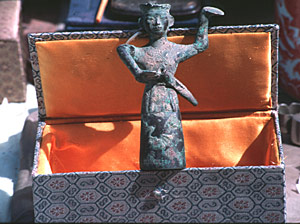 Sources
at leading auction houses say that good fakes are nearly impossible to spot.
"Even dealers are fooled," says Karin Weber, who runs a gallery above
Hollywood Road, a fashionable Central Hong Kong street packed with antique
shops. Some say as many as 80 percent of the goods offered here are fake.
Sources
at leading auction houses say that good fakes are nearly impossible to spot.
"Even dealers are fooled," says Karin Weber, who runs a gallery above
Hollywood Road, a fashionable Central Hong Kong street packed with antique
shops. Some say as many as 80 percent of the goods offered here are fake.
Stories abound about the tricks used to fool experts. "Everyone knows a dozen ways to cheat you," my guide in Jingdezhen cautions as we move through a dark part of town called Fan Jia Jing. Shops here don’t display antiques - only licensed dealers in China can, officially anyway - but queries invariably elicit the same response: furtive glances up and down the street, then a quick retreat to a closet or cellar, where a carefully wrapped, old-looking piece is produced.
"They're all fakes," my guide advises. "Everyone knows how to do it. You rub the piece in chemicals or animal urine to dull the shine. You use dirt and ash in the cracks to age it."
Huang Yunpeng is one of the remarkable characters rebuilding Jingdezhen’s reputation. After 20 years overseeing repairs at the Jingdezhen Ceramic Museum, he is now the director of the Jia Yang Ceramic Studio—and a master copier. One of his fake Ming jars, for example, goes for $300; the original sold for nearly $6 million at a Sotheby’s auction a couple years ago in Hong Kong, then a record.
"I can copy anything," boasts Huang. His Hong Kong partners provide catalogues from auction houses in New York and London. Museum books abound with other masterful designs.
Huang trains scores of workers to reproduce patterns favored by Chinese newlyweds in New York and housewives in Taipei. These days, talent is supplemented by computers. Customers scan images of priceless designs and send them by e-mail. Technology has also been a boon to cheats. Authenticators place great value on the chop, an elegant, intricate Chinese character used to sign ancient pieces and an easy way to tell fakes from the real thing. But now chops can be copied by laser and e-mailed to ceramic shops.
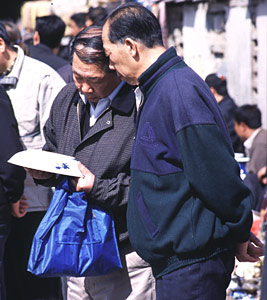 The
most dependable method for testing antiques is thermoluminescence (TL). The
process, explains Doreen Stoneham, head of England’s Oxford Authentication,
the world’s foremost TL lab, involves drilling a small sample of powder from
an object. When heated, the powder emits a faint light signal indicating the
amount of time that has passed since the object was fired.
"Unfortunately," laments Stoneham, "this is no longer sufficient
to detect fakes." She won't detail the reasons, but counterfeiters can
predict where the tests are likely to be done and inject radioactive material
there, says Wang.
The
most dependable method for testing antiques is thermoluminescence (TL). The
process, explains Doreen Stoneham, head of England’s Oxford Authentication,
the world’s foremost TL lab, involves drilling a small sample of powder from
an object. When heated, the powder emits a faint light signal indicating the
amount of time that has passed since the object was fired.
"Unfortunately," laments Stoneham, "this is no longer sufficient
to detect fakes." She won't detail the reasons, but counterfeiters can
predict where the tests are likely to be done and inject radioactive material
there, says Wang.
"There’s no scientific test that is entirely accurate," concedes Pola Antebi, director of the Chinese Ceramics & Works of Art Department at Christie’s in Hong Kong. She and her colleagues rely on their senses to sift out fakes. "We look at so many factors: the shape; the color of the glaze and whether it’s consistent with the period in question; the glaze texture; the weight of the piece; and the mark [chop]," she says. "We look at Chinese ceramics all day, every day." That experience, she maintains, gives experts the edge. "Forgers haven’t had the privilege of handling authentic pieces. It takes years to get the sense of it."
Still, the phony goods creep through. "There are fakes in every auction. Fantastic sums are at stake, and it can’t be helped," says Wang. "The experts are human, too." Embarrassing mistakes are commonplace, adds Bruce Doar, editor of China Archaeology and Art Digest. "Even the best museums have fakes."
New York’s Metropolitan Museum of Art, for example, has had its Chinese works challenged often in the past. One ongoing controversy involves the 1997 acquisition of a group of remarkable Chinese paintings, including "Riverbank," which the Met maintains is an exceptionally rare 1,000 year-old silk scroll. Many scholars credit it instead to modern-day Chang Ta-Chien, a colorful character who typifies the blurred vision afflicting western curators who try to categorize Chinese art. Chang is considered both China's Picasso and one of the greatest con artists of the 20th century.
Chang is believed to be responsible for 30,000 paintings, including countless forgeries. Not that that paints him as a rogue in Chinese art circles. After his death in 1983, several exhibitions of Chang's most famous fakes were held. As to "Riverbank," the question of authenticity has been the topic of numerous seminars and several books, but remains spectacularly unsettled.
In the field of Chinese art, it's an expensive but hardly isolated example. "There are fantastic forgeries out there - that's no secret," says Murck, who spent 12 years at the New York Met. She details the tremendous scrutiny that surrounds every potential purchase. "We could spend months on a single piece," she says. "We'd test it and review its history."
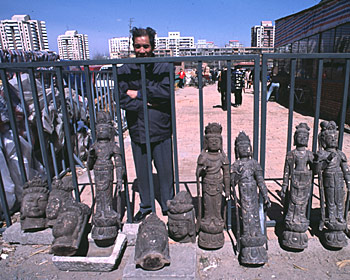 One
reason Chinese art is so susceptible to fraud, however, is that few pieces
possess the kind of ownership trail common in the West.
Sales in China are rarely recorded, and the
artist seldom attributed. Pieces are more commonly assigned
to periods of craft, such as the various dynasties. Antebi describes extensive
vetting procedures, including consultation with investigators who monitor
the latest forgery techniques. "We can't talk about the techniques for
fear of tipping off forgers," she says.
Nevertheless, she allows, "Nothing is foolproof."
One
reason Chinese art is so susceptible to fraud, however, is that few pieces
possess the kind of ownership trail common in the West.
Sales in China are rarely recorded, and the
artist seldom attributed. Pieces are more commonly assigned
to periods of craft, such as the various dynasties. Antebi describes extensive
vetting procedures, including consultation with investigators who monitor
the latest forgery techniques. "We can't talk about the techniques for
fear of tipping off forgers," she says.
Nevertheless, she allows, "Nothing is foolproof."
Though the risks remain high, collectors and museums remain enthusiastic about Chinese art, which most consider to be undervalued. This helps explain both its current popularity and the record prices recorded at practically every big auction.
Hence, even experts like Murck and Wang admit to spending their weekends at Panjiayuan, dubbed Beijing's Junk Market for obvious reasons. Huge piles of newly-minted Qing dynasty wares sit alongside Mao memorabilia. Yet there is always the hope of finding a precious Ming plate among the junk.
Wang once bought a small snuff bottle here for $6,000. A month later, he sold it for $50,000. Wang says cheerfully, "You lose some, but sometimes you win."
Ron Gluckman is an American reporter based in Hong Kong, who roams around Asia for a number of publications, such as Travel & Leisure, which ran this long story on Chinese art forgery in 2,001. This version, though, is from the June 2002 issue of Destinasian (www.destinasian.com).
All pictures by Ron Gluckman
To return to the opening page and index
push here
[right.htm]
